“Promote fashion that is artisanal, handmade and good for the environment.”
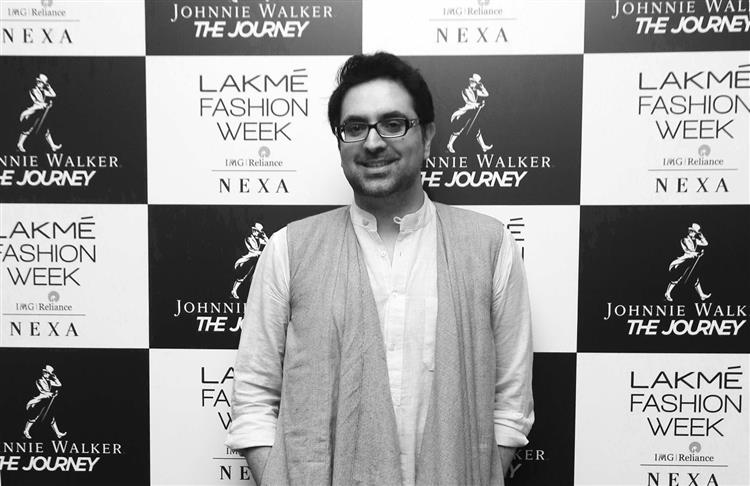
Profile:
Name: Gautam Vazirani
Occupation: Fashion curator, Sustainability at IMG Reliance
Instagram: @gautamvazirani
– – –
currentMood: Where do you think the Indian sustainable fashion industry stands in the global market?
Gautam Vazirani: Our industry is minuscule in terms of sustainable fashion globally, but it’s considered to be a sourcing hub for sustainable raw materials. It will take time for Indian labels to make a mark Internationally. However, it’s important to recognise a few champions who’ve done so already – Maku Textiles by Santanu Das, is a label that works with khadi and natural indigo from Bengal. It’s now retailing out of 11 concept stores in Japan. Matr, another label from Bihar that makes khadi. Their sustainable fabrics are bought by niche international labels like Kopal and Because of Nature. Another such label is Coimbatore based, Ethicus – they grow their own organic cotton and make their own fabric. They are supplying to the Italian and Japanese market. So we do have a special status in the world in terms of raw materials and craftsmanship and there is a great potential to grow. It all depends on how we make people aware of what we do.
cM: What are some of the easiest and cost effective ways designers can engage with ethical fashion?
GV: Sustainable fashion has two spectrums in India. First, to use discarded materials – and you can make a lot out of it. I was a Sari is one such label from Mumbai. They purchase old saris and convert them into high fashion garments. Then, there’s Kurio, a label that uses old rubber from tyres and discarded handloom fabrics to make shoes and footwear. Both these labels are not heavy duty in terms of investments but are creating right process.
Second, is handmade textiles. Millions of weavers and artisans work across India and create fabrics that represent their cultural identity. On National Handloom Day, young designers tied up with the Ministry of Textiles and worked with various artisans from across the country. Our country is blessed with diversity in creativity in terms of artists and fabrics. Designers need to be clear about why they choose to be sustainable – not because it’s a trend. You have to imbibe the philosophy.
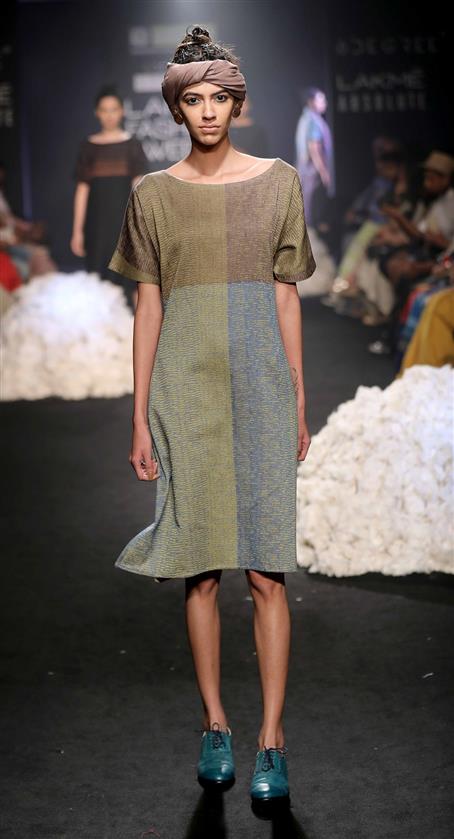
Ethicus at LFW A/W17
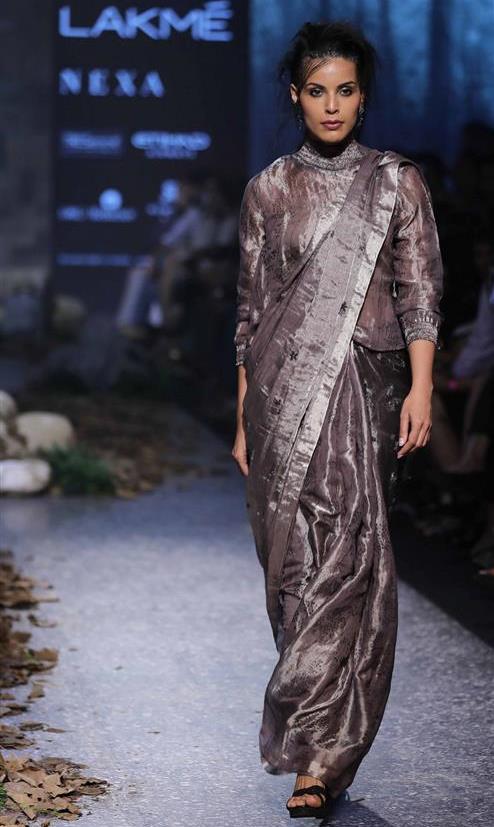
Anavila at LFW A/W17
cM: Sustainability is a hard sell these days – especially because there aren’t any governing bodies that can certify the designer’s claims. Keeping that in mind, how do you shortlist designers for LFW sustainable day?
GV: There aren’t any standardised certifications. Though there are a few market recognised certifications, they aren’t widely accepted. It’s very difficult to decipher who’s sustainable and to what extent. Selections depend upon the way designers operate. Anavila for example, only uses handlooms. 80 percent of her fabric comes from the same artisans she’s been working with since she started her label 8 years ago. We’ve been working with her for a while now, and got to see her commitment to the cause. So we make our assessment accordingly.
This season we’re highlighting Craftmark, a market recognised
certificate that was started by All India Artisans and Craftworkers Welfare Association (AIACA). A team assess your business model and products. Right from the conditions of craftsmen involved to the labels social impact, and techniques such as weaving and dyeing are factored in. If you fit their criteria, your brand gets certified.
The government has also launched India Handloom Brand (IHB). Once you apply for it, everything goes through a laboratory test. If you meet their requirements you get an IHB certificate. Anandi Enterprises and Geetanjali Woollens have Global Recycling Standard (GRS), a certificate given if you’re complying with sustainable procedures and minimising the negative environmental impact. Sometimes these tools help us judge a labels commitment to sustainability. Besides this, we interview designers and ask them where their fabrics come from and how is the brand sustainable.

Doodlage at LFW A/W17
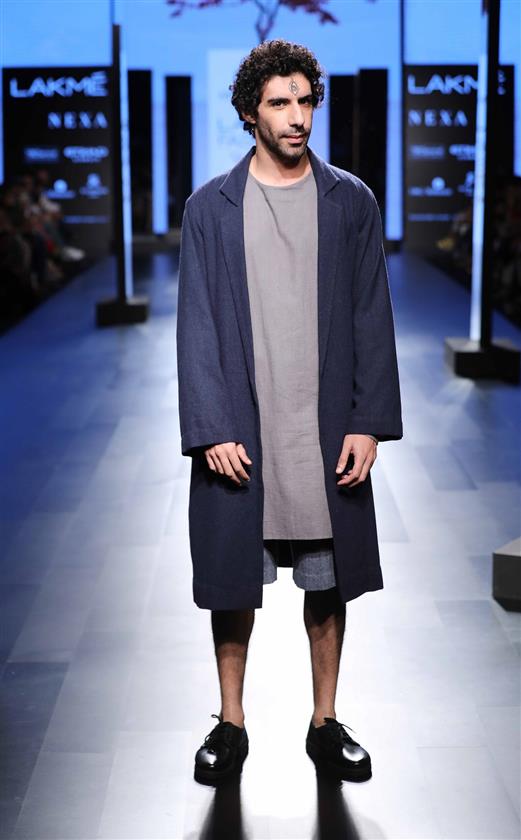
Anuj Bhutani at LFW A/W17
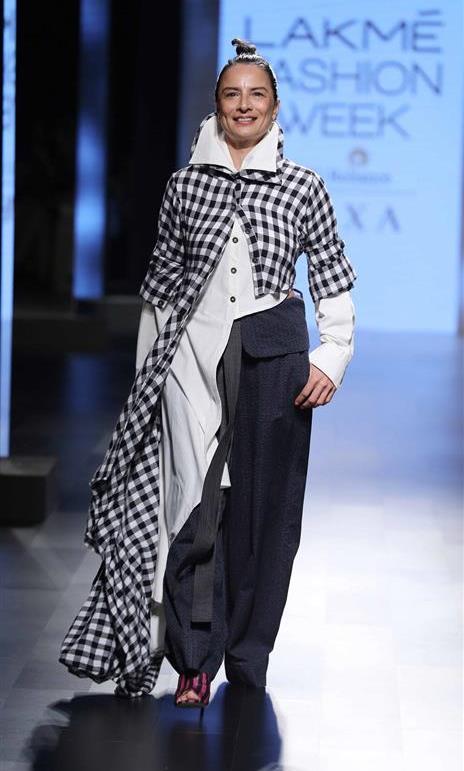
Chola at LFW A/W17
cM: The minute one hears the words ‘sustainable fashion’, people usually tend to think about bohemian looking clothes and not luxury. The west has Stella McCartney and Vivienne Westwood – luxury brands whose USP is sustainability. Why do you think we don’t have its equivalent yet?
GV: Indian fashion industry hasn’t evolved yet. Labels like Stella McCartney have investments from Kering, whereas Indian designer labels are still on their own and are not widely popular in the global market yet. Designers such as Anavila, Sanjay Garg and Akaaro by Gaurav Jai Gupta are sustainable luxury labels. Gaurav’s label is 100 percent handloom and incorporates luxurious materials like merino wool and innovative metal textiles. It will take us time to get to Stella McCartney or Vivienne Westwood’s scale – factors like management, distribution, government support are also involved in the success of a label.
cM: The Indian designers you selected won an award at the International Fashion Showcase Exhibition at London Fashion Week. How did you decide which designers to take on board?
GV: IMG Reliance collaborated with British Fashion Council (BFC) to kickstart the UK India year of culture in 2017. International Fashion Showcase is a highly prestigious fashion platform with 26 countries participating. We chose young, emerging designers who had a knack of working with natural fabrics and had a unique identity. So we worked with Antar-Agni, Kaleekal, Ka-Sha, Ikai and P.E.L.L.A for this. We wanted to create an authentic Indian narrative by choosing Indian pastoral tribes as our concept, and worked with those engaging in animal husbandry. The theme explored how local wisdom can be used to tackle global issues of sustainability. Our designers chose one tribe that inspired them and integrated its unique characteristics into their end product. End result? The jury loved what they saw!
“Fashion week reaches out to 80 to 90 million people via social media hence sending out the right message becomes important.”
cM: Were buyers receptive towards these garments?
GV: You know, everybody, not just the buyers but even the influencers and the media said that they saw something different from India – contemporary, subtle and minimal designs as opposed to the over the top fashion that they’re used to.
cM: Tell us about the Copenhagen Fashion Summit you attended.
GV: I got the opportunity to understand innovations and developments that are taking place internationally. It was also a chance to see how the west is tackling their issues of sustainability. There was so much to learn there. Higg Index for one, it was started by Sustainable Apparel Coalition (SAC) in San Francisco. They constitute 40 percent of the market in terms of retailers and brands. It’s a performance improvement tool, that tackles environmental and social impact of fashion on key areas. This one of a kind facility guides you on various levels – from the usage of water, raw materials you are using to energy consumption, all the critical areas are mapped.
The next two insights were also fascinating. In a study conducted
by Global Fashion Agenda, the organising body for the Copenhagen Fashion Summit and Boston Consulting Group, they mapped brands and retailers across the board and came up with a Pulse Report. It basically looked at Higg Index as a tool to study how sustainable brands are. The overall score was as low as 32 percent, which means we still have a long way to go. They assess a number of areas such as working conditions for labour, environmental impact etc. Then William McDonough’s talk about Cradle to Cradle Certification, which focuses on circular fashion was insightful. The system uses discarded fast fashion to create new raw materials, sustainably. World’s Global Style Network (WGSN) also conducted a seminar where they questioned why we can’t tell consumers that sustainability is sexy.
Another important learning for me was fast fashion. It thrives on the constant idea of something cheap and interesting being thrown at you. It’s created a value system where you don’t want to repeat clothes. High-street brands taught consumers what fast fashion is – by selling clothes for €2! It’s now their responsibility to re-educate consumers about sustainability. Fashion Revolution had done a very interesting campaign where they created a vending machine that sold t-shirts for €2. Only catch was that you had a to watch a short video on how the t-shirt was made – in sweatshops.
cM: What brought about the change in LFW’s show calendar from textile day to sustainability day?
GV: The purpose of textile day at LFW was to promote fashion that is artisanal, handmade and good for the environment. The value behind these principles is sustainability and this is what the global conversation is all about. We’re trying to make designers understand what sustainable fashion is, I don’t think it’s something that’s taught very well in colleges in India..
cM: So in a way you educate emerging designers about sustainability via your shows..
GV: Yes. We had two shows at LFW this season that promoted this cause.One was called #Craftiscool, where five designers tied up with five artisans and create something. The other was the Post Consumer Waste show, where Doodlage, Chola and Anuj Bhutani collaborated with people who produce post consumer waste fabrics, like Anandi Enterprises, Geetanjali, and Conserve India. So by integrating designers into these stories, they get exposed to new concepts, which in turn educates the system on the whole. Fashion week reaches out to 80 to 90 million people via social media hence sending out the right message becomes important. Fashion becomes a tool to influence a lot of people out there and has the power to alter opinions, choices, and attitudes.
Interviewed by: Anupam Dabral
All image courtesy: Gautam Vazirani